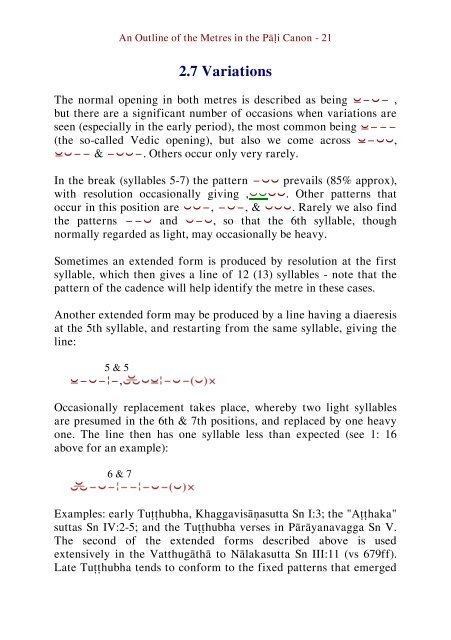An Outline of the Metres in the Pāḷi Canon
A concise but thorough explanation of the metres that are found in the Pāli canon, along with examples and glossary.
A concise but thorough explanation of the metres that are found in the Pāli canon, along with examples and glossary.
You also want an ePaper? Increase the reach of your titles
YUMPU automatically turns print PDFs into web optimized ePapers that Google loves.
<strong>An</strong> <strong>Outl<strong>in</strong>e</strong> <strong>of</strong> <strong>the</strong> <strong>Metres</strong> <strong>in</strong> <strong>the</strong> <strong>Pāḷi</strong> <strong>Canon</strong> - 21<br />
2.7 Variations<br />
The normal open<strong>in</strong>g <strong>in</strong> both metres is described as be<strong>in</strong>g ⏓−⏑− ,<br />
but <strong>the</strong>re are a significant number <strong>of</strong> occasions when variations are<br />
seen (especially <strong>in</strong> <strong>the</strong> early period), <strong>the</strong> most common be<strong>in</strong>g ⏓−−−<br />
(<strong>the</strong> so-called Vedic open<strong>in</strong>g), but also we come across ⏓−⏑⏑,<br />
⏓⏑−− & −⏑⏑−. O<strong>the</strong>rs occur only very rarely.<br />
In <strong>the</strong> break (syllables 5-7) <strong>the</strong> pattern −⏑⏑ prevails (85% approx),<br />
with resolution occasionally giv<strong>in</strong>g ,⏑⏑⏑⏑. O<strong>the</strong>r patterns that<br />
occur <strong>in</strong> this position are ⏑⏑−, −⏑−, & ⏑⏑⏑. Rarely we also f<strong>in</strong>d<br />
<strong>the</strong> patterns −−⏑ and ⏑−⏑, so that <strong>the</strong> 6th syllable, though<br />
normally regarded as light, may occasionally be heavy.<br />
Sometimes an extended form is produced by resolution at <strong>the</strong> first<br />
syllable, which <strong>the</strong>n gives a l<strong>in</strong>e <strong>of</strong> 12 (13) syllables - note that <strong>the</strong><br />
pattern <strong>of</strong> <strong>the</strong> cadence will help identify <strong>the</strong> metre <strong>in</strong> <strong>the</strong>se cases.<br />
<strong>An</strong>o<strong>the</strong>r extended form may be produced by a l<strong>in</strong>e hav<strong>in</strong>g a diaeresis<br />
at <strong>the</strong> 5th syllable, and restart<strong>in</strong>g from <strong>the</strong> same syllable, giv<strong>in</strong>g <strong>the</strong><br />
l<strong>in</strong>e:<br />
5 & 5<br />
⏓−⏑−¦−,<br />
Occasionally replacement takes place, whereby two light syllables<br />
are presumed <strong>in</strong> <strong>the</strong> 6th & 7th positions, and replaced by one heavy<br />
one. The l<strong>in</strong>e <strong>the</strong>n has one syllable less than expected (see 1: 16<br />
above for an example):<br />
6 & 7<br />
Examples: early Tuṭṭhubha, Khaggavisāṇasutta Sn I:3; <strong>the</strong> "Aṭṭhaka"<br />
suttas Sn IV:2-5; and <strong>the</strong> Tuṭṭhubha verses <strong>in</strong> Pārāyanavagga Sn V.<br />
The second <strong>of</strong> <strong>the</strong> extended forms described above is used<br />
extensively <strong>in</strong> <strong>the</strong> Vatthugāthā to Nālakasutta Sn III:11 (vs 679ff).<br />
Late Tuṭṭhubha tends to conform to <strong>the</strong> fixed patterns that emerged

















